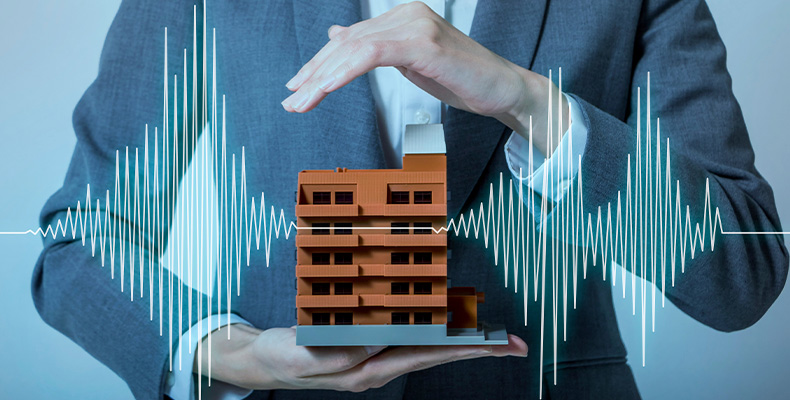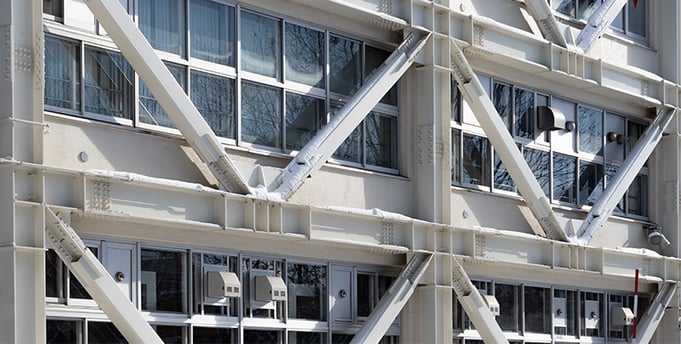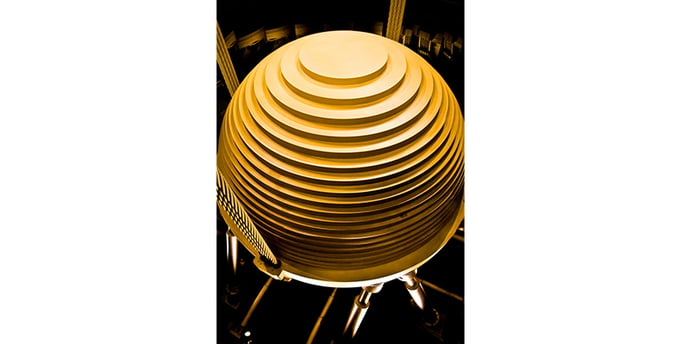What can vibration dampers do for earthquake-resistant construction?

Effective, easy to install, cost-efficient: Vibration dampers are ideal for dissipating earthquake-induced energy from the main structure. Learn how the different damping systems function in earthquake-resistant construction.
How does a vibration damping system work?
Vibration damping systems encompass energy-absorbing devices which are installed into the building structure to dissipate a large portion of the induced energy.
Such energy absorption elements are not normally the main load-bearing components of a structure. Yet, structural deformation or vibrations cause these devices to move resulting in the energy being dissipated. In this way, dynamic responses and resulting damage to the main structure can be reduced effectively.
Energy dissipation by fluid viscous dampers
Liquid viscous dampers work according to the principle of energy dissipation: The damper consists of a steel piston that is divided into two chambers by the piston head, a compressible hydraulic fluid (silicone oil), and a pressure accumulator to ensure smooth circulation of the fluid.
When the piston moves, the liquid flows through the orifice from one chamber into the other. The movement from the larger to the smaller area (orifice) and back from the smaller to the larger area (cylinder chamber) reduces energy due to pressure loss.
Fluid viscous dampers are able to work in ambient temperatures from -40°C to +70°C (Constantinou and Symans, 1992). Unlike other dampers – e.g. viscoelastic dampers – temperatures changes only have a minor effect on the performance of these devices (Constantinou and Symans, 1992).
A drawback, however, is that the seals of liquid viscous dampers require careful maintenance over extended operational periods to prevent the escape of oil (Sadek et al., 1996).
Hysteretic metallic dampers
To dissipate energy, metallic dampers use the property of plastic hysteretic deformation of a specific metal. Commonly used representatives of these damping systems include mild steel dampers, buckling-restrained braces (BRB), and lead dampers.

There are several configurations of mild steel dampers, e.g. X-shaped steel plate dampers and triangular-shaped dampers. Such dampers are composed of several X-shaped steel plates or triangular steel plates, resp. The vibration energy is dissipated by the lateral bending yield of the steel plates to reduce the vibration response of the structure.
Mild steel dampers are mainly characterized by their stable hysteretic performance and good fatigue properties at low cycles as well as their high insensitivity to environmental influences.
Buckling-restrained braces and lead dampers
Buckling-restrained braces show the same load-deformation behavior, whether under compression or under tension. In addition, they stand out for a higher energy absorption capacity while providing easy adjustability of stiffness and strength. In the event of a light earthquake, buckling-restrained braces increase the stability of buildings. During larger earthquakes, the buckling-restrained braces create plastic hysteretic deformation to dissipate energy.
On the other side, lead dampers dissipate vibration energy by using the benefits of lead extrusion or shear-hysteretic deformation of lead. Like mild steel dampers, lead dampers have excellent stability and durability properties. In addition, they are insensitive to environmental influences. A disadvantage is, however, that the lead in the damper can pollute the environment.
Viscoelastic damper utilize shear-hysteretic deformation
Viscoelastic dampers (VE dampers) consist of viscoelastic layers which are connected with steel plates by sulfurization. By utilizing the principle of shear-hysteretic deformation of viscoelastic materials, these dampers dissipate structural vibration energy.
The hysteresis curve of viscoelastic dampers shows full ellipses. This indicates that they have an excellent energy dissipation capacity. Further advantages include that they are easy to design, produce, durable and low-priced.
Viscoelastic dampers can be used in new buildings, for seismic retrofits and for reconstruction after an earthquake. The drawback of these dampers is, however, that the viscoelastic material is sensitive to temperature fluctuations.
Tuned mass dampers reduce dynamic response
This type of damper includes tuned mass dampers (TMD) and tuned liquid dampers (TLD). The energy of the main structure is transmitted to the dampers which are tuned to the frequency of the controlled main structure and thus attenuate dynamic responses.
The TMD system consists of a mass, springs and dampers which are usually mounted on top of the main structure. The mass, stiffness and damping can be adjusted in such a manner that the natural period is identical or similar to the natural period of the main structure. When the main structure starts to move, the TMD system generates a force in the opposite direction of the main structure. Dynamic responses of the main structure are effectively reduced. Mass dampers are easy to design and produce.
TMD systems offer outstanding damping performance
As TMD systems only have a minor effect on the function of the main structure, they are often used to reduce the dynamic response of a structure exposed to earthquake or wind forces.

If it is a narrow-band excitation, or if the vibration is controlled by the fundamental oscillation, the damping effect will be excellent – otherwise the damping effect will be inferior. Consequently, the TMD system can only suppress dynamic responses of the main structure within a narrow range of the excitation frequency.
TLD systems use water for energy absorption
The tuned liquid damper is a kind of tuned mass damper where the mass is replaced by water or other liquids. It uses the same basic principle of dissipating energy from the main structure as the TMD system.
Because of its practical application and cost-effectiveness, the system is popular and frequently employed. A very important aspect is the sloshing behavior of a free surface liquid contained in a tank. Even small movements of the container can create relatively strong fluid motions because high pressure loads are generated when the liquid hits the walls of the container. To prevent damage and to reduce the adverse effects of sloshing, baffles or deflectors are often installed so that the original height of the liquid level is quickly restored after structural vibration has occurred.
In general, passive tuned dampers are easy to install and maintain. Not only can they be used in new buildings, but also in existing buildings to improve seismic performance.
Find out in the next part of our article series which RINGFEDER® solutions can contribute to the sustainable increase in the earthquake protection of buildings and structures.


Comment